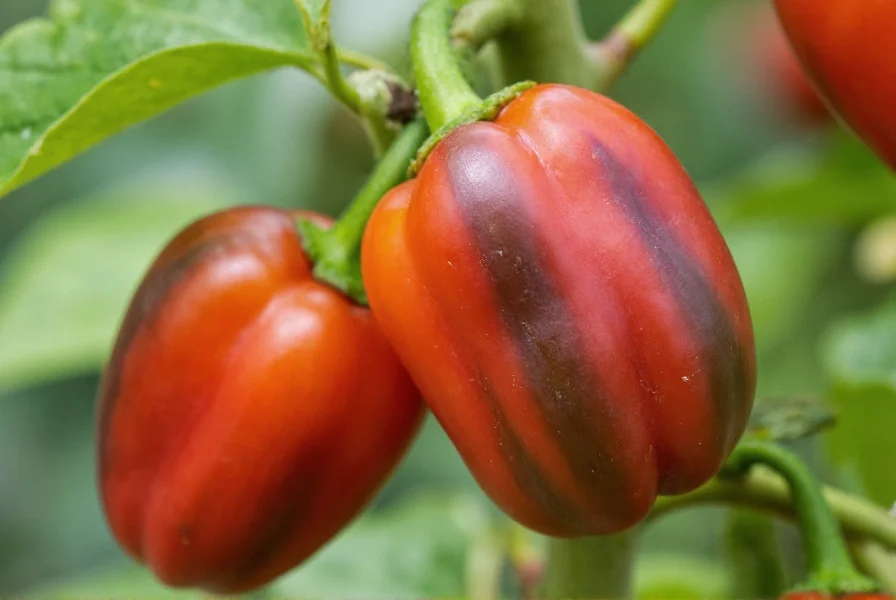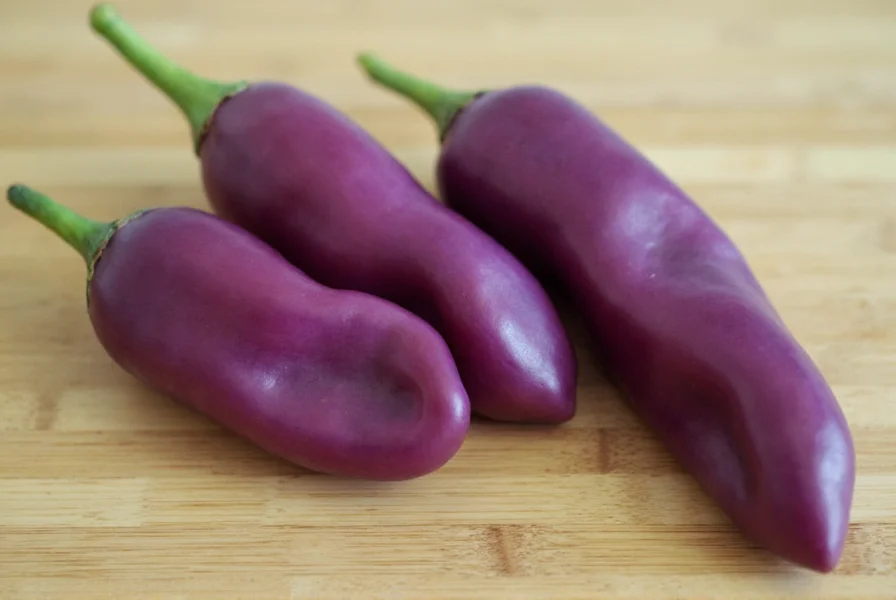Many gardeners and food enthusiasts search for "purple peppers" expecting a unique cultivar, but the reality of pepper coloration is more nuanced. While no pepper variety remains consistently purple throughout its lifecycle, several types display striking purple tones under specific growing conditions. This article explores the science behind these color variations, identifies which pepper varieties commonly exhibit purple hues, and examines practical limitations affecting their cultivation.
The Science Behind Pepper Coloration
Pepper colors transform through distinct stages as they mature, governed by pigments that develop at different growth phases. The purple tint appears due to anthocyanins—water-soluble pigments also found in blueberries and red cabbage. These compounds emerge when:
- Peppers experience significant temperature fluctuations
- Plants receive intense sunlight exposure
- Certain genetic traits express during ripening
- Nutrient levels in soil affect pigment production
Unlike the carotenoids responsible for red, orange, and yellow hues that stabilize in mature peppers, anthocyanins typically serve as a temporary phase before transitioning to final colors. According to USDA Agricultural Research Service studies, anthocyanins function as a protective mechanism against UV radiation and temperature stress, explaining their heightened production under environmental pressure (USDA ARS, 2010).

Pepper Varieties That Develop Purple Hues
Several common pepper varieties display purple characteristics during specific growth stages:
| Pepper Variety | Purple Appearance Stage | Final Mature Color | Notable Characteristics |
|---|---|---|---|
| Black Hungarian | Early ripening stage | Bright red | Develops deep purple-black when young |
| jalapeño (certain strains) | Mid-ripening phase | Bright red | Purple streaks appear before final color |
| Lemon Drop | Transitional phase | Bright yellow | Purple shoulders develop in full sun |
| Aji Charapita | Developing fruit stage | Orange to red | Small fruits show purple veins when young |
Color Evolution Timeline: Black Hungarian Pepper
Understanding the precise progression of color change is essential for harvesting at the optimal purple stage. Research from Howard et al. (1994) documented the pigment development in peppers, revealing a consistent pattern in varieties like Black Hungarian:
| Development Stage (Days After Flowering) | Color Appearance | Pigment Dominance | Harvest Recommendation |
|---|---|---|---|
| 0-20 | Green | Chlorophyll | Early harvest for mild flavor |
| 21-30 | Purple streaks to full purple | Anthocyanins peak | Optimal for vibrant purple color |
| 31-40 | Purple fading to red | Carotenoids increase | Transition phase, mixed pigments |
| 41+ | Bright red | Carotenoids dominant | Full maturity, sweetest flavor |
Source: Howard et al., "Color Development and Pigment Analysis in Pepper (Capsicum annuum L.) Fruit," Journal of the American Society for Horticultural Science, 119(6), 1032-1037 (1994).
Practical Limitations of Purple Pepper Cultivation
While gardeners can encourage purple coloration, several inherent constraints affect consistency and duration:
- Temporary Nature: The purple phase is always transitional; anthocyanins degrade as fruit matures and carotenoids dominate. No variety maintains purple color indefinitely (Howard et al., 1994).
- Climate Dependency: Significant temperature fluctuations (10-15°F difference between day and night) are crucial for anthocyanin production. Regions with consistently warm temperatures (e.g., USDA Zones 10-11) may see minimal purple development without artificial climate control.
- Duration Constraints: The peak purple stage typically lasts only 5-7 days under optimal conditions. Extended heat above 90°F (32°C) can shorten this window to 2-3 days, as documented in University of California field trials.
- Genetic Variability: Even within the same variety, individual plants show inconsistent expression due to epigenetic factors. Cornell University's Plant Breeding program notes that only 60-75% of Black Hungarian plants develop pronounced purple hues under identical conditions.
These constraints explain why "permanent purple" peppers do not exist in nature and why commercial growers rarely target this phase for market.
Nutritional Profile of Purple-Hued Peppers
Peppers displaying purple tones contain higher anthocyanin levels during their transitional phase. These compounds offer antioxidant benefits similar to those found in other purple-hued produce. However, nutritional content shifts as peppers mature:
- Vitamin C: Highest in green peppers, decreases slightly as color changes
- Carotenoids: Increase significantly as peppers reach final color stage
- Anthocyanins: Peak during purple phase, diminish as peppers mature further
- Capsaicin: Concentration varies by variety, not directly related to color changes
For maximum nutritional diversity, harvest peppers at multiple stages of ripening. The purple transitional phase offers unique phytonutrients not present in fully mature peppers.
Cultivation Tips for Enhancing Purple Hues
Gardeners seeking pronounced purple coloring in their peppers should consider these growing techniques:
- Sun exposure: Provide 8-10 hours of direct sunlight daily to stimulate anthocyanin production
- Temperature management: Maintain daytime temperatures between 75-85°F (24-29°C) with 10-15°F (6-8°C) cooler nights
- Soil composition: Ensure phosphorus levels of 30-50 ppm while avoiding excessive nitrogen (University of Georgia Cooperative Extension, 2022)
- Water consistency: Maintain even moisture without overwatering, which dilutes pigment concentration
- Harvest timing: Pick peppers when purple coloration is most vibrant for culinary use

Culinary Applications for Purple-Tinged Peppers
Chefs and home cooks can leverage purple-hued peppers for both flavor and visual appeal. The taste profile during the purple phase often features:
- Milder heat levels compared to fully mature counterparts
- Slightly sweeter flavor with subtle berry notes
- Firmer texture ideal for slicing and grilling
- Vibrant color that fades when cooked (best used raw)
For optimal visual impact in dishes, add purple-tinted peppers during the final preparation stages. Their distinctive color makes them excellent for:
- Raw vegetable platters and crudités
- Salsas and fresh relishes
- Thinly sliced garnishes for salads
- Pickled preparations that preserve some color
Common Misconceptions About Purple Peppers
Several myths persist about purple peppers that deserve clarification:
- Misconception: Purple peppers are a distinct species
Reality: They're transitional stages of common varieties - Misconception: Purple color indicates higher heat level
Reality: Heat depends on capsaicin concentration, not color - Misconception: All purple peppers turn red
Reality: Final color depends on the specific variety's genetics - Misconception: Purple peppers are genetically modified
Reality: Color variations occur naturally through selective breeding
Conclusion
While true purple peppers as a permanent variety don't exist, the temporary purple hues that appear in certain pepper types offer both visual interest and unique nutritional benefits. Understanding the ripening process helps gardeners maximize these color displays and cooks incorporate them effectively in dishes. The purple phase represents just one beautiful stage in the natural color progression of peppers, each with its own flavor profile and culinary applications. By recognizing these transitional stages and their inherent limitations, pepper enthusiasts can appreciate the full spectrum of colors and flavors these versatile vegetables provide.











 浙公网安备
33010002000092号
浙公网安备
33010002000092号 浙B2-20120091-4
浙B2-20120091-4